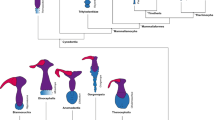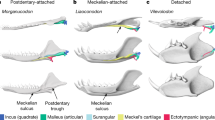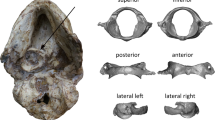Abstract
THE upright posture and obligatory bipedalism of modern humans are unique among living primates. The evolutionary history of this behaviour has traditionally been pursued by functional analysis of the postcranial skeleton and the preserved footprint trails of fossil hominids. Here we report a systematic attempt to reconstruct the locomotor behaviour of early hominids by looking at a major component of the mechanism for the unconscious perception of movement, namely by examining the vestibular system of living primates and early hominids. High-resolution computed tomography was used to generate cross-sectional images of the bony labyrinth. Among the fossil hominids the earliest species to demonstrate the modern human morphology is Homo erectus. In contrast, the semicircular canal dimensions in crania from southern Africa attributed to Australopithecus and Paranthropus resemble those of the extant great apes. Among early Homo specimens, the canal dimensions of Stw 53 are unlike those seen in any of the hominids or great apes, whereas those of SK 847 are modern-human-like
This is a preview of subscription content, access via your institution
Access options
Subscribe to this journal
Receive 51 print issues and online access
$199.00 per year
only $3.90 per issue
Buy this article
- Purchase on Springer Link
- Instant access to full article PDF
Prices may be subject to local taxes which are calculated during checkout
Similar content being viewed by others
References
Latimer, B. & Lovejoy, C. O. Am. J. phys. Anthrop. 78, 369–386 (1989).
Tuttle, R. H. in Laetoli: A Pliocene Site in Northern Tanzania (eds Leakey, M. D. & Harris, J. M.) 503–523 (Oxford Univ. Press, Oxford, 1987).
Susman, R. L., Stern, J. T. & Jungers, W. L. Folia Primatol. 43, 113–156 (1984).
Hartwig-Scherer, S., & Martin, R. D. J. hum. Evol. 21, 439–499 (1991).
Ten Kate, J. H., Barneveld, H. H. & Kuiper, J. W. J. exp. Biol. 53, 501–514 (1970).
Oman, C. M., Marcus, E. N. & Curthoys, I. S. Acta Otolaryngol. 103, 1–13 (1987).
Muller, M. & Verhagen, J. H. G. J. theor. Biol. 134, 473–501 (1988).
Blanks, R. H. I., Estes, M. S. & Markham, C. H. J. Neurophysiol. 38, 1250–1268 (1975).
Goldberg, J. M. & Fernandez, C. J. Neurophysiol. 34, 635–660 (1971).
Turkewitsch, B. G. Ztschr Anat. Entwicklungsgesch. 103, 551–608 (1934).
Hadziselimovic, H. & Savkovic, L. J. Acta anat. 57, 306–315 (1964).
Matono, S., Kubo, T., Matsunaga, T., Niemitz, C. & Günther, M. in Current Perspectives in Primate Biology (eds Taub, D.M. & King, F. A.) 122–129 (Van Nostrand Reinhold, New York, 1986).
Zonneveld, F. W. & Wind, J. in Hominid Evolution: Past, Present and Future (ed. Tobias, P. V.) 427–436 (Liss, New York, 1985).
Spoor, C.F. & Zonneveld, F. W. Cour. Forsch. Senckenberg 171, 251–256 (1994).
Muller, M. J. theor. Biol. 167, 239–256 (1994).
Rose, M. D. Am. J. phys. Anthrop. 63, 371–378 (1984).
Walker, A. in The Nariokotome Homo erectus Skeleton (eds Walker, A. & Leakey, R.) 411–430 (Springer, Berlin, 1993).
Robinson, J. T. Early Hominid Posture and Locomotion (Univ. Chicago Press, Chicago, 1972).
Vrba, E. S. Am. J. phys. Anthrop. 51, 117–130 (1979).
McHenry, H. M. J. hum. Evol. 15, 177–191 (1986).
Hunt, K. D. J. hum. Evol. 26, 183–202 (1994).
Wood, B. Nature 363, 587–588 (1993).
Susman, R. L. Am. J. phys. Anthrop. 79, 451–474 (1989).
Johanson, D. C. et al. Nature 327, 205–209 (1987).
Walker, A. in Homo erectus: Papers in Honor of Davidson Black (eds Sigmon, B.A. & Cybulski, J.) 193–215 (Univ. Toronto Press, Toronto, 1981).
Clarke, R. J. in Hominid Evolution: Past, Present and Future (ed. Tobias, P. V.) 171–177 (Liss, New York, 1985).
Grine, F. E., Demes, B., Jungers, W. L. & Cole T. M. Am. J. phys. Anthrop. 92, 411–426 (1993).
Kimbel, W. H. & Rak, Y. in Species, Species Concepts, and Primate evolution (eds Kimbel, W. H. & Martin, L. B.) 461–484 (Plenum, New York, 1993).
Dean, M. C. & Wood, B. A. Am. J. phys. Anthrop. 59, 157–174 (1982).
Spoor, C. F. thesis, Urecht Univ. 1993.
Curthoys, I. S., Blanks, R. H. I. & Markham, C. H. J. Morph. 151, 1–16 (1977).
Berg, W. Ztschr. Morph. Anthr. 5, 315–345 (1903).
Blanks, R. H. I., Curthoys, I. S., Bennett, M. L. & Markham, C. H. Brain Res. 340, 315–324 (1985).
Gray, A. A. The Labyrinth of Animals (Churchill, London, 1907).
Ramprashad, F., Landolt, J. P., Money, K. E. & Laufer, J. Am. J. Anat. 169, 295–313 (1984).
Fleagle, J. Primate Adaptation and Evolution (Academic, San Diego, 1988).
McHenry, H. Am. J. phys. Anthrop. 87, 407–431 (1992).
Author information
Authors and Affiliations
Rights and permissions
About this article
Cite this article
Spoor, F., Wood, B. & Zonneveld, F. Implications of early hominid labyrinthine morphology for evolution of human bipedal locomotion. Nature 369, 645–648 (1994). https://doi.org/10.1038/369645a0
Received:
Accepted:
Issue Date:
DOI: https://doi.org/10.1038/369645a0
This article is cited by
-
Morphology of the Bony Labyrinth Supports the Affinities of Paradolichopithecus with the Papionina
International Journal of Primatology (2023)
-
New fossils from Kromdraai and Drimolen, South Africa, and their distinctiveness among Paranthropus robustus
Scientific Reports (2022)
-
Parallel evolution of semicircular canal form and sensitivity in subterranean mammals
Journal of Comparative Physiology A (2022)
-
Cochlear shape distinguishes southern African early hominin taxa with unique auditory ecologies
Scientific Reports (2021)
-
A test of the lateral semicircular canal correlation to head posture, diet and other biological traits in “ungulate” mammals
Scientific Reports (2020)
Comments
By submitting a comment you agree to abide by our Terms and Community Guidelines. If you find something abusive or that does not comply with our terms or guidelines please flag it as inappropriate.



